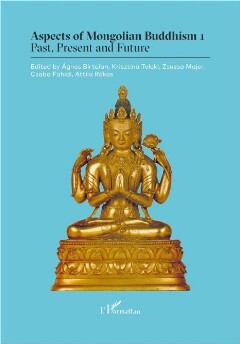Oldal 421 [421]
CZECHOSLOVAK ACADEMIC STUDY OF BUDDHISM IN THE 1950s AND 1960s: FIELD RESEARCH IN ASIA
temples. In commemoration of Buddha’s 2500 anniversary they created a large Budd¬
ha image and a stupa and engraved a Manjushri image on a rock.”?!
It is the only mention in non-Mongolian literature about a consecration ceremony”
for Buddha’s stupa that we have been able to find. However, Lumir Jisl was the first in
the history to describe the ceremony; namely in his English and German monograph
with photographic documentation, which was published two years after the event.
The consecration ceremony for the newly erected stupa of Buddha Shakyamuni
took place near the main temple of Gandantegchenling on the afternoon of 9" July
1958. This looks like simple information about a ceremony, but the significance of the
event is striking. Here, we should mention the religious situation in Mongolia in 1958,
in order to highlight the historic importance of the ceremony. Since the end of World
War II until the mid-1980s, there was only one open monastery in the entire country:
Gandantegchenling in Ulaanbaatar which was the only place where religious rituals
and conventions of monks (Mong. qural) could be held and which housed the Budd¬
hist educational base for future monks since the year 1970. And yet, at the beginning
of the 1920s there were more than six hundred monasteries, temples and other sacral
buildings in Outer Mongolia (Mong. Aru Mongyol, called also Khalkha). The fact is
that a similar ceremony of stupa consecration as was held in 1958 could take place
in Mongolia only before the revolution, followed by approximately four decades of
brutal anti-religious reprisals. Both lamas and novices (Mong. qubaray) were forced to
leave monasteries, imprisoned, executed without trial and in better cases were forced to
renounce their monastic wows, and many of them had to spend several years in labor
camps and later embark on the “path of builders of socialism.”™
The participants of the first Czechoslovak-Mongolian archaeological expedition
stayed in Ulaanbaatar in July 1958,** before they set out to a remote excavation site. The
Anonymus: Buddhism in Mongolia: Historical Review. Gandantegchinling Monastery, Ulaanbaatar 1979,
p. 8.
The term consecration is not the most suitable one in the context of Buddhism, however, it is used in
English (see e.g. Bentor, Yael: Consecration of Images and Stupas in Indo-Tibetan Tantric Buddhism
(Brill’s Indological Library, Vol. 11). Brill, Leiden 1996). The ritual of rawnai (Tib. rab gnas) consists
in opening a sculpture or picture for the use of believers.
See for instance: Jerryson, Michael K.: Mongolian Buddhism: The Rise and Fall of the Sangha. Silkworm
Books, Bangkok 2007; Kaplonski, Christopher: Truth, History and Politics in Mongolia: The Memory
of Heroes. RoutledgeCurzon, London 2004; Kaplonski, Christopher: Prelude to violence: Show trials
and state power in 1930s Mongolia. American Ethnologist Vol. 35. No. 2. (2008), pp. 321-337.
This was the first Czechoslovak-Mongolian expedition ever; for details see: Martinovsky, Martin:
Ceskoslovensko-mongolska archeologicka expedice v roce 1958 [Czechoslovak-Mongolian archaeo¬
logical expedition in 1958]. H. Barvikova (ed.): Véda v Ceskoslovensku v letech 1953-1963. Archiv
Akademie véd Ceské republiky, Praha 2000, pp. 415-446; see also Smahelovä, Lucie: Külteginäv pamät¬
nik a vyzkum éeskoslovensko-mongolské expedice [Kitiltegin Memorial and research of the Czechoslo¬
vak-Mongolian archaeological expedition in 1958]. LukaS Pecha (ed.): Orientalia Antiqua Nova VIL.
Zapadoéeska univerzita, Plzeh 2008, pp. 392-403.
419

